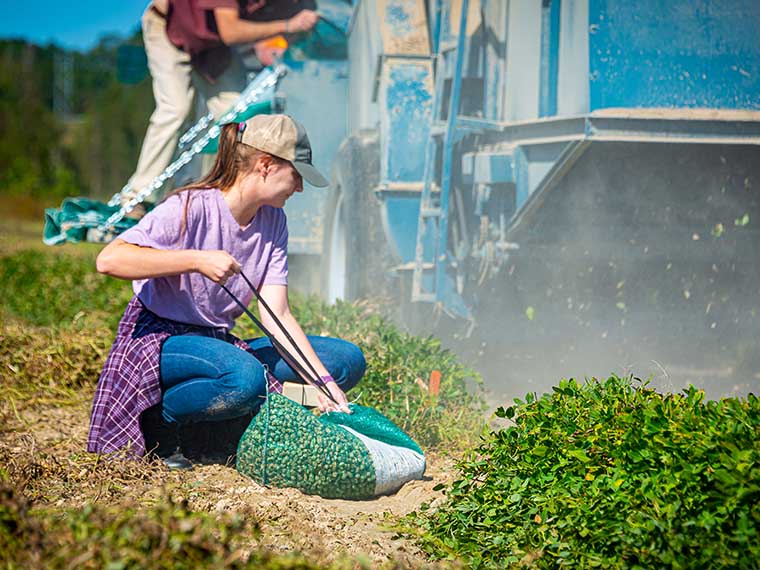The information presented on this page may be dated. It may refer to situations which have changed or people who are no longer affiliated with the university. It is archived as part of Mississippi State University's history.
ANNA BETH GAUDIN GREW UP ON A DAIRY farm in Starkville. Though she and her family still live on the land, the dairy itself has gone out of business, and rather than giving into the disappointment, Gaudin stood up and devoted herself to helping other producers avoid the same fate.
After receiving her undergraduate in agronomy at Mississippi State, Gaudin decided to try her hand for a master's in weed science, and now through her thesis research under Dr. Connor Ferguson, she is getting to work directly with farmers, hoping her research will help the state's 113 peanut producers.
"This study partners with three growers who let us use their fields, and in return, we're able to connect with them through the research and hopefully give them some type of advantage in the end," Gaudin said.
This research, specifically, strives to understand the best application timing for plant growth regulator, Prohexadione-Calcium (Pro-Hex), in peanut fields. The efficiency of peanut harvest can vary if canopy growth isn't regulated; Pro-Hex is one such regulator. The product label recommends two applications, once when 50 percent of the vines are touching and again when 100 percent of the vines are touching, but Gaudin and her fellow researchers are testing the product in various iterations to find the best combination of applications for growth and yield.
"We understand that growers are busy and that they might not have the time to go and check whether exactly 50 percent of the vines are touching, or they might not see that 100 percent are touching until a few days later," Gaudin said. "We wanted to know how far we could stray from the application label without sacrificing results."
Though the research is only in its first year, Gaudin and her team have already tested the product at several key points in the plant's growth cycle, including when less than 50 percent of the vines are touching and after 100 percent of the vines are touching. They also experimented with administering two Pro-Hex treatments in one week while 100 percent of the vines are touching. A common theme among all combinations of applications, Gaudin shared, was that it was better to apply at any tested level of vines touching rather than not at all.
In the coming years of the research, they plan to repeat these trials as well as introduce similar ones with different rates of Pro-Hex compared to the labeled recommendation, and while the procedure will largely remain the same, Gaudin has plans to incorporate new technology into the data-gathering process.
"With peanuts, the canopy closure, or what percent of the vines are touching, is important information to have, but it can be difficult to quickly get an idea of the field overall without a bird's-eye view. For that reason, we're planning to test routes of precision agriculture like drones and other applications that can take images and return the percent canopy closure. We'll compare the aerial estimates with infield observations to determine its accuracy," Gaudin said.
In preparation of this development, Gaudin has been working towards her unmanned aerial vehicle pilot's certification. She said the benefit of gaining her pilot's certificate won't end with this research; instead, it will follow her through her career.
"UAV technology in ag is an emerging field, and one that is rapidly expanding its application," Gaudin said. "I'm excited to be a part of that, and I'm excited to see how this technology can be utilized to help the producers. Anything that I can take to a grower or consultant and it be useful to them, that's what I've always wanted to do."
This research is funded by the Mississippi Peanut Promotion Board.

